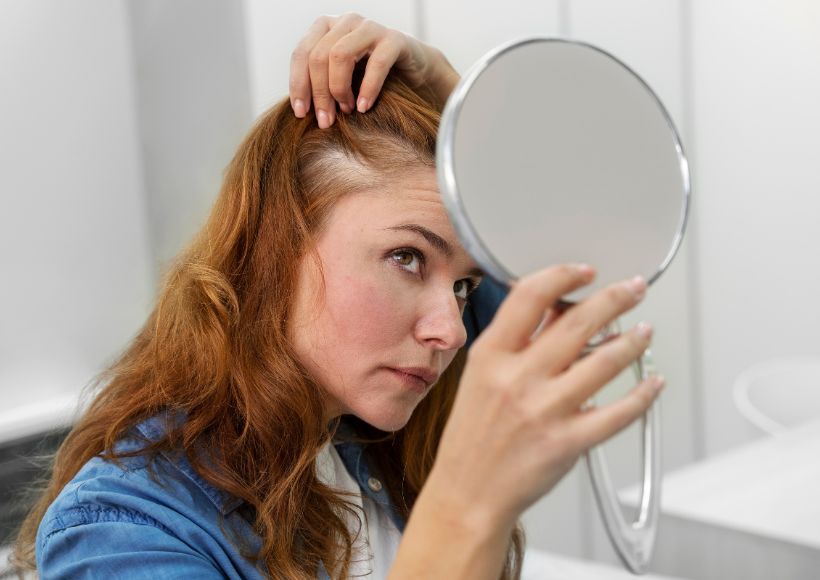Have you noticed unusual thinning in your hair or even areas where the hair is sparser than normal? If so, you are not alone. Female alopecia or , simply, hair loss in women, is a reality that many face in silence.
In this article, we will delve into the universe of alopecia in women, exploring its causes, identifying its symptoms and, most exciting of all, we will introduce you to peptides , that innovative answer that is changing the game in the treatment of alopecia. hair loss .
Table of Contents
Female alopecia: Is there really a solution?
Female alopecia is one of those issues that is often whispered in conversations between friends, consulted during nightly Internet searches, or analyzed in detail in front of the bathroom mirror. But, given the evidence of hair that is thinning or losing density , the question that is on the minds of many is: Is there really a solution to this problem?
In the universe of beauty and hair care, countless solutions have been proposed: from fortifying shampoos to invasive treatments. While many of these solutions have proven to be effective, they do not fully meet everyone’s needs.
Common causes of alopecia in women: Why does it happen?
Understanding female alopecia is starting by knowing its causes . Contrary to what you may think, it is not simply a natural aging process. Hair loss in women can be influenced by multiple factors , each of them with their own characteristics and solutions. Let’s explore some of the most common causes .
- Hormonal imbalances . Changes in hormone levels, such as those that occur during menopause, pregnancy, or due to thyroid problems, can lead to temporary or permanent loss.
- Stress . Yes, stress not only affects your mind and body, but also your hair. High stress situations can lead to a condition called telogen effluvium, where hair falls out in large amounts.
- Genetics . As in men, androgenetic alopecia (or female pattern baldness) may be a cause. If several women in your family have experienced hair loss, there could be a genetic predisposition.
- Certain medications . Some medications, especially those to treat cancer, arthritis, depression, heart disease, among others, can have hair loss as a side effect.
- Diet and nutrition . A lack of certain nutrients, such as iron or protein, can impact the health of your hair.
- Autoimmune diseases . Conditions such as alopecia areata, where the immune system attacks the hair follicles, is another common cause in these cases.
Recognizing the cause is the first step to finding a solution. However, it is crucial to understand that each woman is unique, and what may be the cause in one person may not be the cause in another. At the first sign, our recommendation is, first of all, to consult with your professional hairdresser and then, if you want to obtain a precise diagnosis, with a dermatologist or trichologist.
Symptoms of hair loss: recognizing the first signs
Therefore, early detection of signs of alopecia in women is essential to intervene appropriately and prevent further progression. These early indicators can often go unnoticed, especially if we are not alert. From here, we want to give you the tools to identify these first symptoms . Pay attention to these signs and don’t let them surprise you!
- Increased hair on the brush . It is natural to lose between 50 and 100 strands daily. However, if your brush suddenly retains more hair than usual after combing your hair, it could be an alarm indicator.
- Finer hair when collected . If when you make a ponytail you feel that it has less density or that you require more twists with the elastic to hold it, it may be a sign that you are losing volume.
- Greater visibility of the scalp . Observe your reflection. If you feel like you can see more skin between your hair, especially in areas like the forehead or crown, you could be experiencing a symptom of alopecia.
- Loss of volume . If your hair used to be thick and now feels like it’s become more limp or lifeless , it’s an indication that something is changing.
Types of female alopecia and how to identify them
Hair loss in women can be classified into several types, each with its own particularities.
- Androgenic Alopecia . Progressive hair loss, especially on the top of the scalp, due to genetic and hormonal factors.
- Alopecia Areata . Hair loss in circular areas or patches. It is related to the immune system.
- Traction Alopecia . Caused by hairstyles that pull the hair tightly. It is reversible if it is detected and the hairstyle is changed.
- Telogen effluvium . Temporary hair loss due to stress, hormonal changes or illness.
- Cicatricial Alopecia . Irreversible loss when injury or inflammation destroys the follicle and scar tissue forms.
- Frontal Fibrosing Alopecia . It affects the front line of the scalp and sometimes the eyebrows.
Also Read : “The Effectiveness And Safety Of RU58841 And Pyrilamine”

